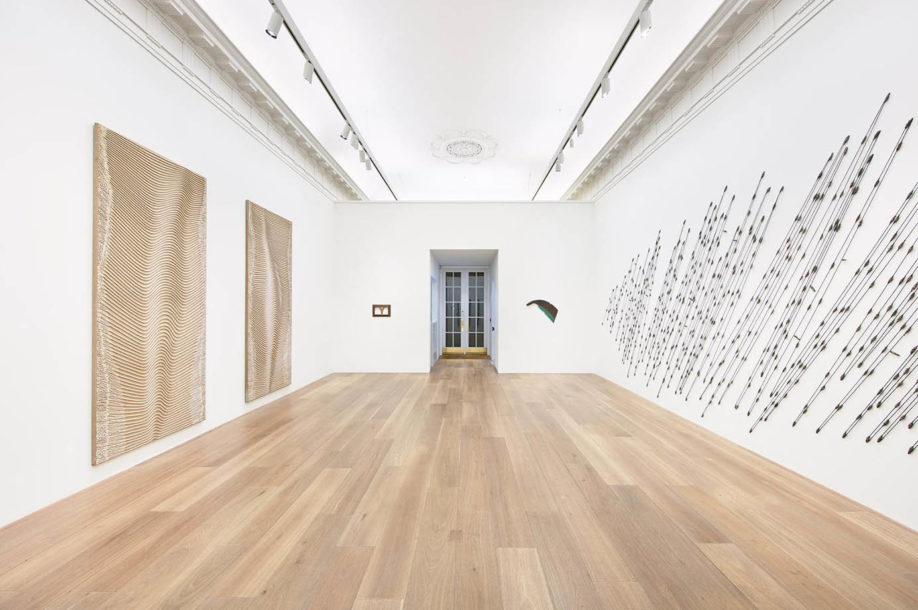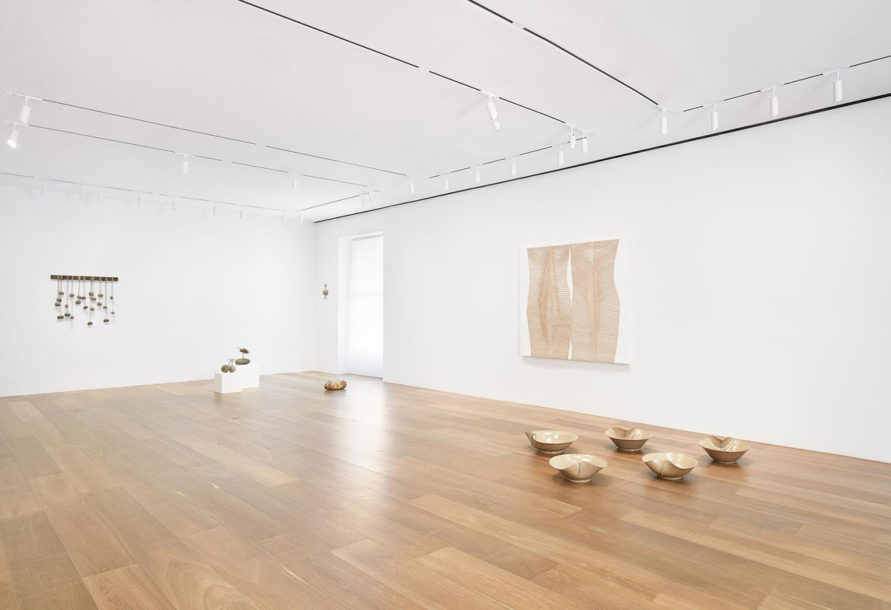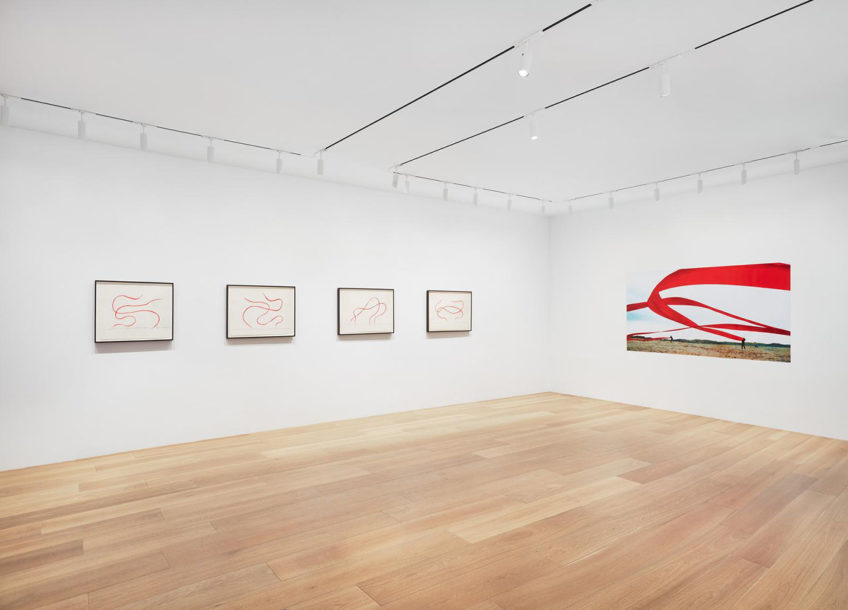
Seung-taek Lee
Seung-taek Lee
Lévy Gorvy is pleased to represent Seung-taek Lee (b.1932) in the United States. Seung-taek Lee’s experimental practice holds an influential place in the history of Korean art; throughout his career, he has challenged traditionally held notions of identity and history, forging a new path for artistic exploration of environment, culture, and philosophy.
A pioneer of the Korean avant-garde and part of the first generation of experimental artists to embrace innovation and modernist influences after the end of the Korean War in 1953, Seung-taek Lee has continuously engaged political and cultural themes over the course of his six-decade career. His diverse and prolific oeuvre encompasses sculpture, installation, performance, and Land art. Notions of negation—which the artist calls dematerialization, non-sculpture, and anti-concept—are central to Seung-taek Lee’s approach, and indicate the process by which ordinary or mundane objects are transformed to be imbued with metaphysical meaning. Using broken tree branches, wire, Korean hanji paper, stones, human hair, fabric, and rope, his works elevate the objects and interactions that comprise daily life to the level of the mythical. Seung-taek Lee’s sculptures often involve environmental themes and his practice corresponds with contemporaneous developments in Land Art, Japanese Mono-ha, and Post-Minimalism.
In the late 1950s, Seung-taek Lee began work on his Godret Stone series, in which the artist affixes rocks to wooden bars with rope; by making the stones appear weightless and soft, he obscures their true physical nature. In the next decade, Seung-taek Lee turned his focus to representing imperceptible or ephemeral natural phenomena such as wind, fire, water, and smoke, further exploring the concept of dematerialization. Seung-taek Lee’s fascination with history led him to believe that the artist’s role is in “connecting different worlds in search of another realm.” His vernacular is eminently materialist and deeply rooted in a sense of place, celebrating the incidental beauty of Korean folk traditions.
Seung-taek Lee’s work resides in the permanent collections of museums and institutions worldwide, including the Tate Modern, London; the National Museum of Modern and Contemporary Art, Seoul; the Museum of Contemporary Art Australia, Sydney; and the Seoul Museum of Art; among others. Solo exhibitions of Seung-taek Lee’s work have been held at the Sungkok Art Museum, Seoul and the Nam June Paik Art Center, Yongin. He received the Eunkwan Award from the Korean Ministry of Culture in 2014 and the Nam June Paik Art Center International Art Award in 2009.
Gallery Hyundai continues their representation of Seung-taek Lee in Asia.
Selected Works
Video
Seung-taek Lee Exhibition
April 6, 2017
Exhibitions
Selected Press
ArtAsiaPacific | Non-Art: The Inversive Act
March 30, 2021
Korea Times | MMCA Seoul revisits Lee Seung-taek's 'non-art'
December 6, 2020
My Art Guides | Lee Seung Taek’s Non-Art: The Inversive Act
November 25, 2020
ArtNet News | Two Landmark US Museum Shows Will Spotlight the Long Overlooked History of Modern and Avant-Garde Korean Art
November 10, 2020
ZEALnyc | Art Break: South Korean Artist In First Solo Exhibition in U.S. at Lévy Gorvy
April 20, 2017
Hyperallergic | The Avant-Garde Oeuvre of a Classically Trained Sculptor from North Korea
April 13, 2017
New York Times | As Top-Tier Artists Age, the Art World Hopes to Cash In
January 30, 2017
The New York Times | Winds From Seoul
November 24, 2016
More Information
Artists
Alexander Calder
Enrico Castellani
Chung Sang-Hwa
Francesco Clemente
Dan Colen
Willem de Kooning
Lucio Fontana
Gego
Yves Klein
Jutta Koether
Seung-taek Lee
Robert Motherwell
Senga Nengudi
Roman Opalka
Adrian Piper
Michelangelo Pistoletto
Carol Rama
Martial Raysse
Peter Regli
Germaine Richier
Karin Schneider
Joel Shapiro
Kazuo Shiraga
Pierre Soulages
Pat Steir
Tu Hongtao
Günther Uecker
Zao Wou-Ki
Specializing in Works By
- Terry Adkins
- Vincenzo Agnetti
- Carl Andre
- Diane Arbus
- Jean Arp
- Francis Bacon
- John Baldessari
- Jean-Michel Basquiat
- Alighiero Boetti
- Lee Bontecou
- Louise Bourgeois
- Mark Bradford
- Constantin Brancusi
- Cecily Brown
- Alberto Burri
- Sérgio Camargo
- Vija Celmins
- John Chamberlain
- Eduardo Chillida
- Lygia Clark
- George Condo
- Joseph Cornell
- Gino de Dominicis
- Nicolas de Staël
- Richard Diebenkorn
- PETER DOIG
- Jean Dubuffet
- Sam Francis
- Helen Frankenthaler
- Lucian Freud
- Alberto Giacometti
- Gilbert & George
- Johannes Girardoni
- Sonia Gomes
- Julio González
- Arshile Gorky
- Adolph Gottlieb
- Mark Grotjahn
- Philip Guston
- David Hammons
- Keith Haring
- Damien Hirst
- David Hockney
- Thomas Houseago
- Jasper Johns
- Donald Judd
- Ellsworth Kelly
- Anselm Kiefer
- Martin Kippenberger
- Franz Kline
- Jeff Koons
- Jannis Kounellis
- Lee Krasner
- Barbara Kruger
- Yayoi Kusama
- Gerald Laing
- Fernand Léger
- Roy Lichtenstein
- Liza Lou
- Tsuyoshi Maekawa
- René Magritte
- Piero Manzoni
- Brice Marden
- Agnes Martin
- Henri Matisse
- Fausto Melotti
- Joel Mesler
- Eleanore Mikus
- Joan Miró
- Joan Mitchell
- Amedeo Modigliani
- Piet Mondrian
- Paulo Monteiro
- Henry Moore
- François Morellet
- Bruce Nauman
- Barnett Newman
- Albert Oehlen
- Claes Oldenburg
- Francis Picabia
- Pablo Picasso
- Lari Pittman
- Sigmar Polke
- Jackson Pollock
- Richard Prince
- Robert Rauschenberg
- Charles Ray
- Ad Reinhardt
- Gerhard Richter
- Jean Paul Riopelle
- Mark Rothko
- Ed Ruscha
- Robert Ryman
- Salvatore Scarpitta
- Thomas Schütte
- Richard Serra
- Cindy Sherman
- Jeff Sonhouse
- Clyfford Still
- Rudolf Stingel
- Mark Tansey
- Mickalene Thomas
- James Turrell
- Cy Twombly
- Andy Warhol
- Tom Wesselmann
- Franz West
- Jonas Wood
- Christopher Wool







